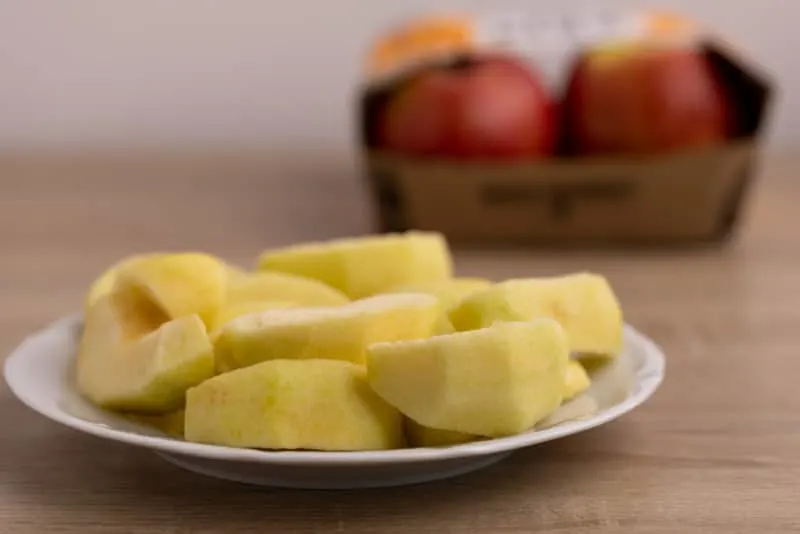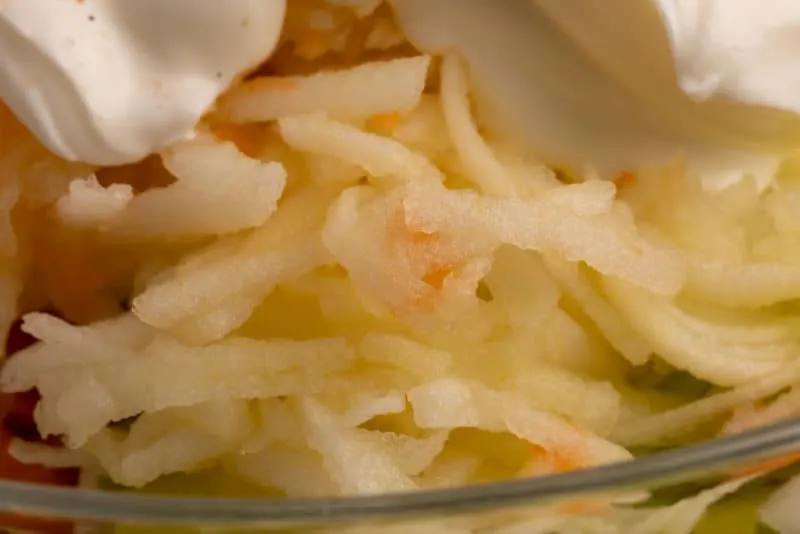Bought too many apples and not sure what’s the best way to store them or how long they are good for? How long do apples last?
Or maybe a relative gave you a whole bunch of apples from their orchard, and you’re trying to figure out how to get the most out of them. Organic apples aren’t cheap, so you don’t want them to spoil.
If either sounds familiar, this article is for you. In it, we’re going to cover:
- storing apples at home without buying any extra baskets or containers
- the shelf life of apples (hint: it’s not the same for every cultivar)
- when to toss out an apple and what to do with slightly older and wrinkly ones
Sounds interesting? Let’s dig in.

How To Store Apples
Store apples in the crisper drawer or a ventilated bag in the fridge. And make sure there’s some space for the fruits to breathe.
If you’re going to eat the apples within a few days, a fruit bowl on the counter is okay. For long-term storage, a cellar or an unheated garage is a decent spot if you have access to one.
That’s the gist of it; let’s get into details.
Apples keep best at 30°- 32°F (or -1° to 0°C) ([PU]), which makes the fridge the best possible option. Any other space that maintains a similar (or a bit higher) temperature is a good choice as well. That means root cellars, garages, and the like.
Humidity and air circulation are next in line. Apples last the longest in humid spots (90 percent relative humidity [PU]) that allow for airflow.
That’s why I suggest either going with the veggie drawer (and no bag) or opting for a perforated bag. Or simply not sealing your plastic bag ([HO]). Either checks both boxes.
Putting a bunch of apples near other veggies or fruits isn’t a good idea. Apples release ethylene gas that might speed up their spoilage ([HO]). Put apples on a different shelf or reserve the whole crisper for them. Or choose only products that don’t respond to ethylene, which will require some research.

Speaking of air circulation, remember to leave about 1/4 of the storage space free ([PU]) so that the ethylene can escape. Ideally, apples shouldn’t stick to one another, but that might not be feasible if you have lots of apples and not much space.
Wash apples under running water right before eating or using them. This way, you don’t risk leaving any extra moisture that might speed up spoilage.
The last practice important for long-term storage of apples is giving them a check every couple of days (or weeks for cultivars that last a long time) and discarding any spoiling or spoiled ones. That’s because the proverb is true – one bad apple can spoil the barrel if it’s got enough time.

Storing Apple Leftovers
If you have kids, leftover cut or sliced apples aren’t anything new to you.
To preserve them for later, transfer them to an airtight container or a freezer bag and into the fridge. That will slow down browning and maintain the quality of the fruit ([HO]).
What’s important to remember is that peeled apples brown if they are exposed to air. Here are some apple slices after only an hour on the counter:

Here, on the other hand, are apples that sat for 4 days in a closed container in the fridge:

The brown streaks are the only sign of prolonged storage, and they look much better than those apples that sat on the counter.
If your child (or you) don’t want to eat those slightly brown apples, add them to a smoothie or blend and top your oatmeal with them. Or eat them blended.
How Long Do Apples Last?
Generally, apples keep for about a week on the counter and between 4 to 6 weeks in the fridge. If you need ones that last longer, there are cultivars such as Red Delicious, Fuji, Idared, Granny Smith, and many more that last much longer.
There are dozens of apple cultivars on the market, and some of them are excellent keeps, while others don’t last nearly as long even in perfect storage conditions ([PU]). Plus, what’s available in your grocery store or farmer’s market depends heavily on where you live.
Because of that, I don’t think giving you a list of cultivars with their storage periods would be useful.

Instead, think of it this way:
- If you don’t have the slightest idea what apples you have bought or don’t care, go with the rule-of-thumb above.
- If you know the cultivar of your apples, google the storage period for it.
- Need apples that will last for a couple of months or the whole winter? Find a list of cultivars available in your state or country, write down a few ones that keep the longest, and buy them.
Besides that, the other piece of the apple storage time puzzle is their quality. The better ones you choose when you buy them, the longer they will last.
The best apples should be firm and crisp, without any bruises, skin breaks, or shriveling ([PU, HO]). Bruises and decay spread quickly in storage, so avoiding them is crucial.
The amount of red color on the surface doesn’t say much about the fruit’s taste and quality ([HO]). Quit thinking the more red there is, the better the apple will be.
When it comes to leftovers, those apple cuts or slices are good for about for 4 to 5 days.

How To Tell If an Apple Is Bad?
Throw out apples that are rotten, shriveled, or soft. You can cut out small spoiled spots, but if that would mean removing a third of the fruit, it’s probably time to let it go.
Apples lose water over time, and the fruit withers and decays ([PU]).
It starts with some wrinkles here and there, then a couple of soft spots form, and then the whole thing becomes soft to the touch. At that point, the fruit is usually still okay to eat, but it’s quite difficult to peel or grate, and it doesn’t taste all that great.
Eating such apple raw or in a fruit salad might not be the most pleasant experience. However, you can always use those apples in smoothies, applesauce, baking, or processing.

When it comes to refrigerated apple slices, throw them out if you see any mold, they smell stale or off in any other way, or if they already sit in storage for more than five days. Again, some brown streaks after a couple of days in the fridge is normal and nothing to be afraid of.
Summary
- Store apples in the veggie drawer or an unsealed bag in the fridge. If you need them to last only a couple of days, leaving them on the counter is okay.
- Transfer apple leftovers into freezer bags or airtight containers and into the fridge.
- Old and soft apples work quite well in smoothies and pies.
